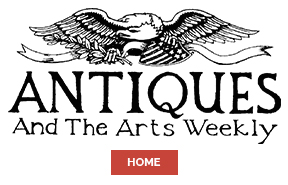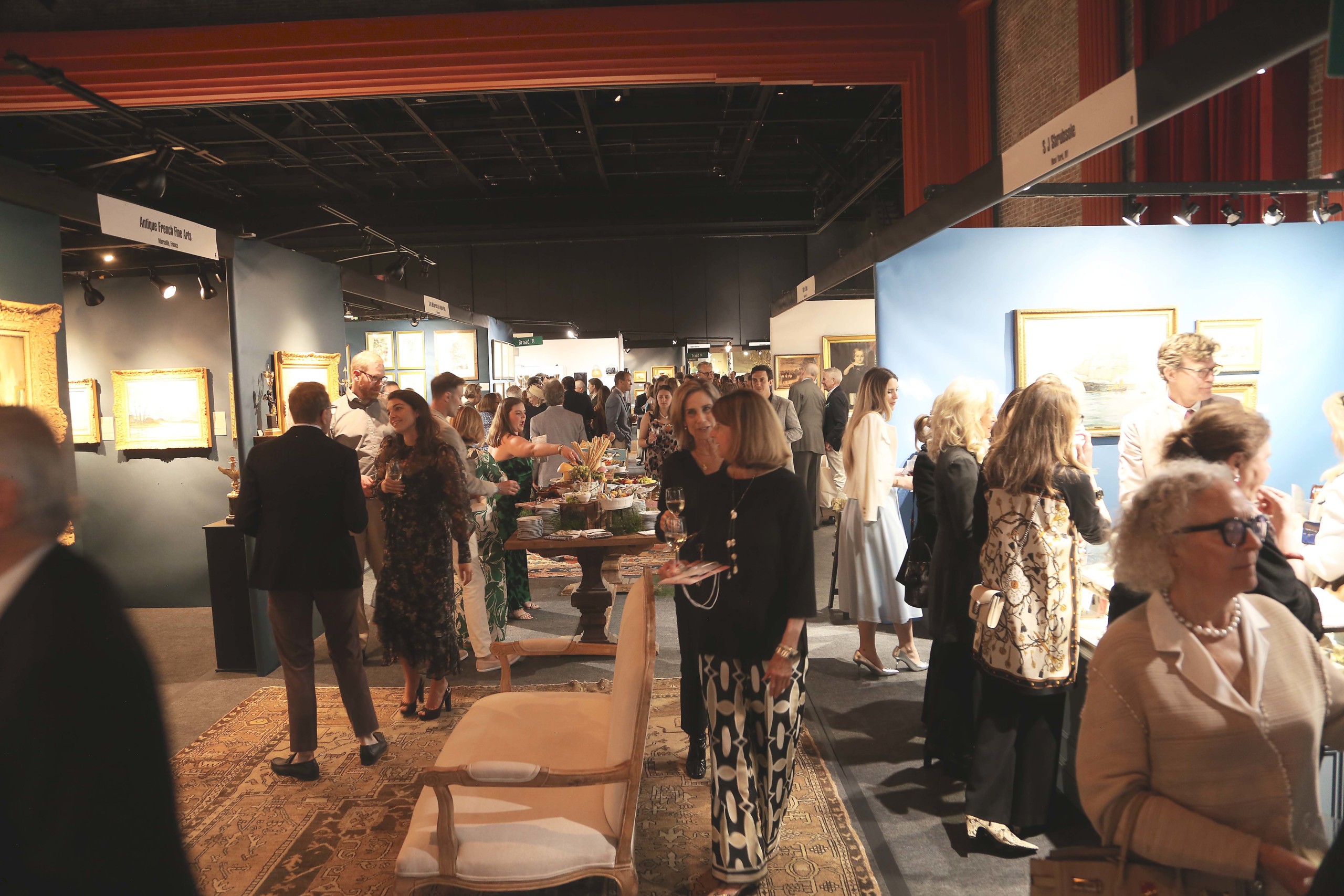
VIPs got into the preview party at 6 pm, with stepped down admission for 7 pm shopping. By 8 pm, the aisles of the show were busy.
Review & Onsite Photos by Madelia Hickman Ring
CHARLESTON, S.C. — A lavish preview party the evening of Thursday, March 20 kicked off the fourth annual Charleston Show, which was open to the public at the Festival Hall in the city’s historic district for three days, March 21-23. The evening benefitted Drayton Hall Preservation Trust and nearly 30 dealers were out in force for the event. Attendance through the weekend was up between 25 and 30 percent from last year, according to Kaye Gregg, one of the two directors of publicity and advertising for the Antiques Council, which oversaw the event.
“Charleston was very good. I think most people felt really good about the crowd and the energy of opening night, which continued all weekend. People came from all over, including Tennessee and Atlanta, so it seems as though it has become kind of a draw.”
Gregg noted that all three public programs — a panel discussion titled “Living With Antiques” on Friday afternoon, a talk and book-signing by honorary show chair Timothy Corrigan on Saturday morning and Sunday afternoon’s “Through the Looking Glass, Decorative Arts Deconstructed” lecture — were all sold out. Additionally, the decorators were welcomed to the show before it opened on Friday morning for coffee and pastries and more personal time with dealers.
The show included three emerging dealers to the show with small booths at the back of the floor. Charleston dealer Sally Simms is the proprietor of Super Saturday, and her booth had an eclectic mix of marquetry furniture, Midcentury Modern furniture, a Flemish style tapestry, glassware and Palissy ware-style plates with lobsters on them. She was having a great time, noting it was “so fun to meet other dealers.”
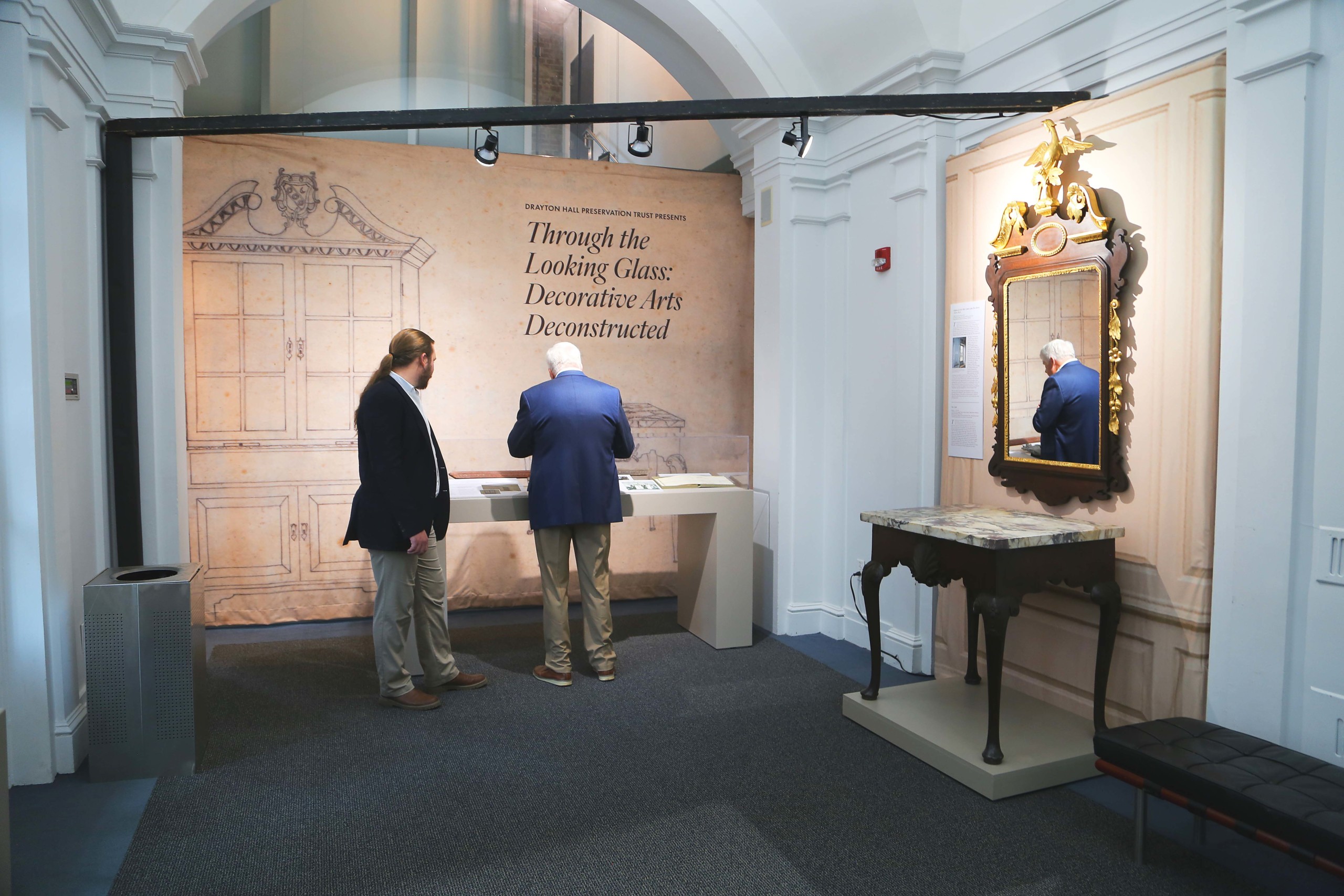
The loan exhibition “Through the Looking Glass: Decorative Arts Deconstructed” was in the lobby of Festival Hall, the Charleston Show’s home for the duration of its run.
Christopher Cawley, from New York City, was another one of the emerging dealers. He centered his booth around an inlaid library table framed by small pieces of furniture that supported porcelains and silver, with two comfortable open armchairs in the back corners. Textile fragments on one side of his booth were opposite a large interior scene on the other. He gave the show a rave review:
“The show was fabulous, especially opening night. Buyers of all ages were clambering to make purchases. We made entirely new connections and did business with local Charleston dealers John Pope and Chris Kellogg. We sold a number of things notably an inlaid Syrian library table and a large scale Eighteenth Century oil on canvas after Hogarth’s ‘A Midnight Modern Conversation.’ The energy for antiques was alive in Charleston, buyers from nearly the womb to the wheelchair were out in full force and actively wanting to purchase beautiful things. We can’t wait for next year.”
Kristin Chambless, along with her husband Sterling, runs North Charleston-based Shoppe Found. The light olive-green paper she’d selected as her booth’s background was a great choice to present her ornithological and botanical prints that they brought and which looked great over the small case pieces on hand.
Andrew Silla of Shippensburg, Penn., was set up next to the emerging dealers; in 2012, he became a full time dealer with his wife, Grace, and the two participate in other Antiques Council shows throughout the country. Sculpture was one of his early passions and his booth always featured several examples, in a variety of sizes and subjects, both human and animal. His back wall featured two large paintings by Henry Scott, with landscapes and animal paintings on other walls.
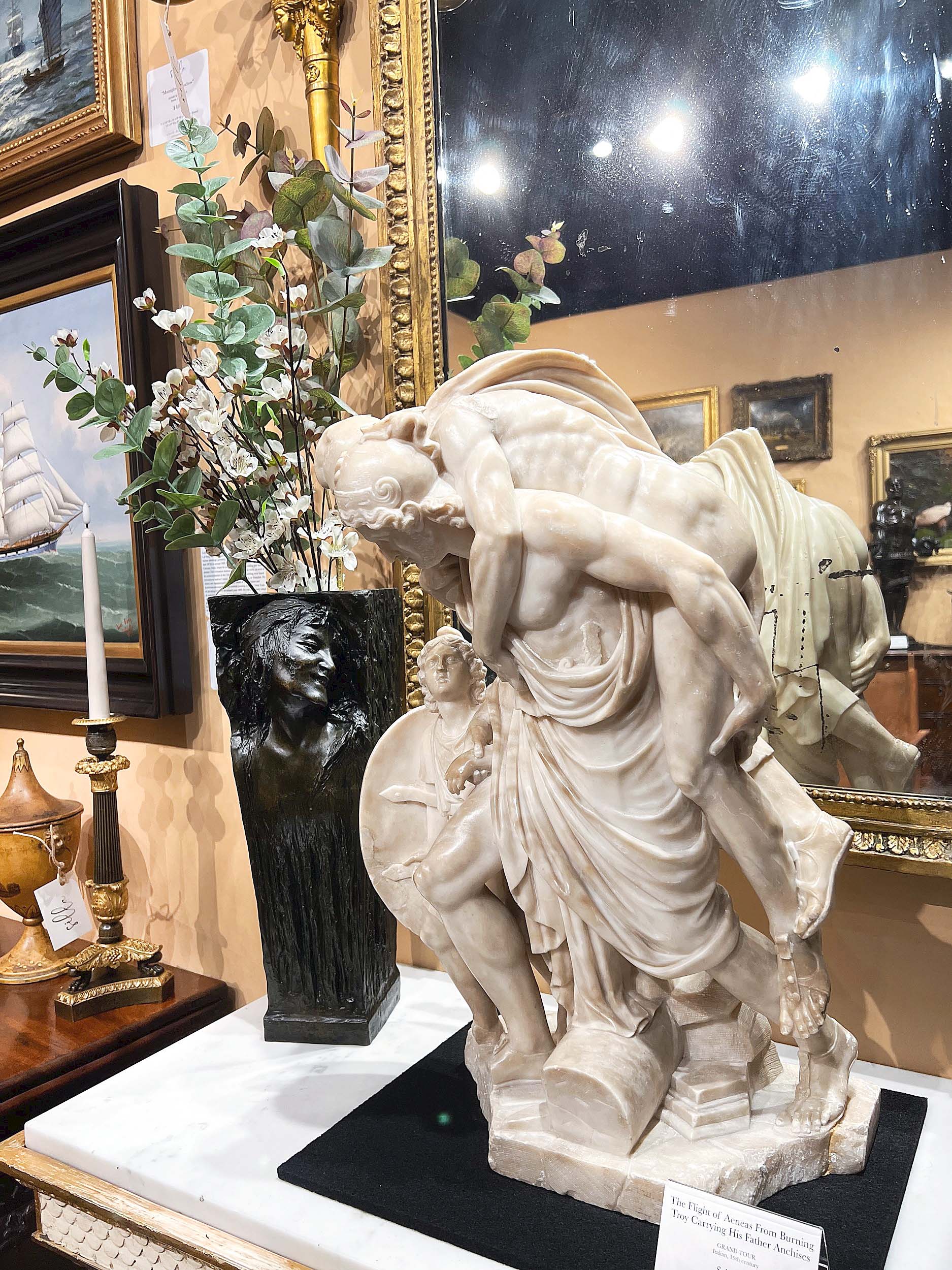
One of the sales Andrew Silla made was this Grand Tour carved alabaster sculpture of Aeneas Fleeing from Burning Troy. Andrew Silla photo. Silla, Shippensburg, Penn.
“It was our first year exhibiting at the Charleston show so we were not sure what to expect,” Silla reported. “We have a pretty active client base surrounding the Charleston area that we invited to the show and many were able to make it. The Antiques Council did a really nice job with marketing the show and I thought it was very well attended. We made many new connections with local collectors and designers and have already had an additional follow-through after the show as well. My favorite piece is one that sold after the show, a Grand Tour carved alabaster sculpture of Aeneas Fleeing From Burning Troy. That is being crated in the gallery right now and will ship out to a collector we met at the show in a few days. All in all, it was a fabulous show and we will be back next year.”
Thurston Nichols’s booth was the first one on the show’s floor and he brought a broad inventory, including folk portraits, landscapes, carved eagles and whales, weathervanes, small furniture and decorative works of art. Occupying pride of place in the center of the Bethlehem, Penn., dealer’s booth were a pair of circa 1930 limestone dogs, carved in the style of William Edmondson, and a late Nineteenth Century zinc statue of George Washington.
Several things stood out in William Cook’s booth, next to that of Nichols. Bronze ballet dancers by Benson Landes, a group of six pastel pictures of chickens by Leslie Bennison and a miniature Victorian tilt-top table, decorated with marquetry and carving, that the UK dealer said was used as a salesmen’s sample and was found in a private house in the UK. But it was a bright-red upholstered chair, made for the 1969 investiture of Charles as Prince of Wales, that received a majority of attention. Cook had sold another such chair at the 2024 Charleston show to a local collector and hoped to have the same luck in this edition.
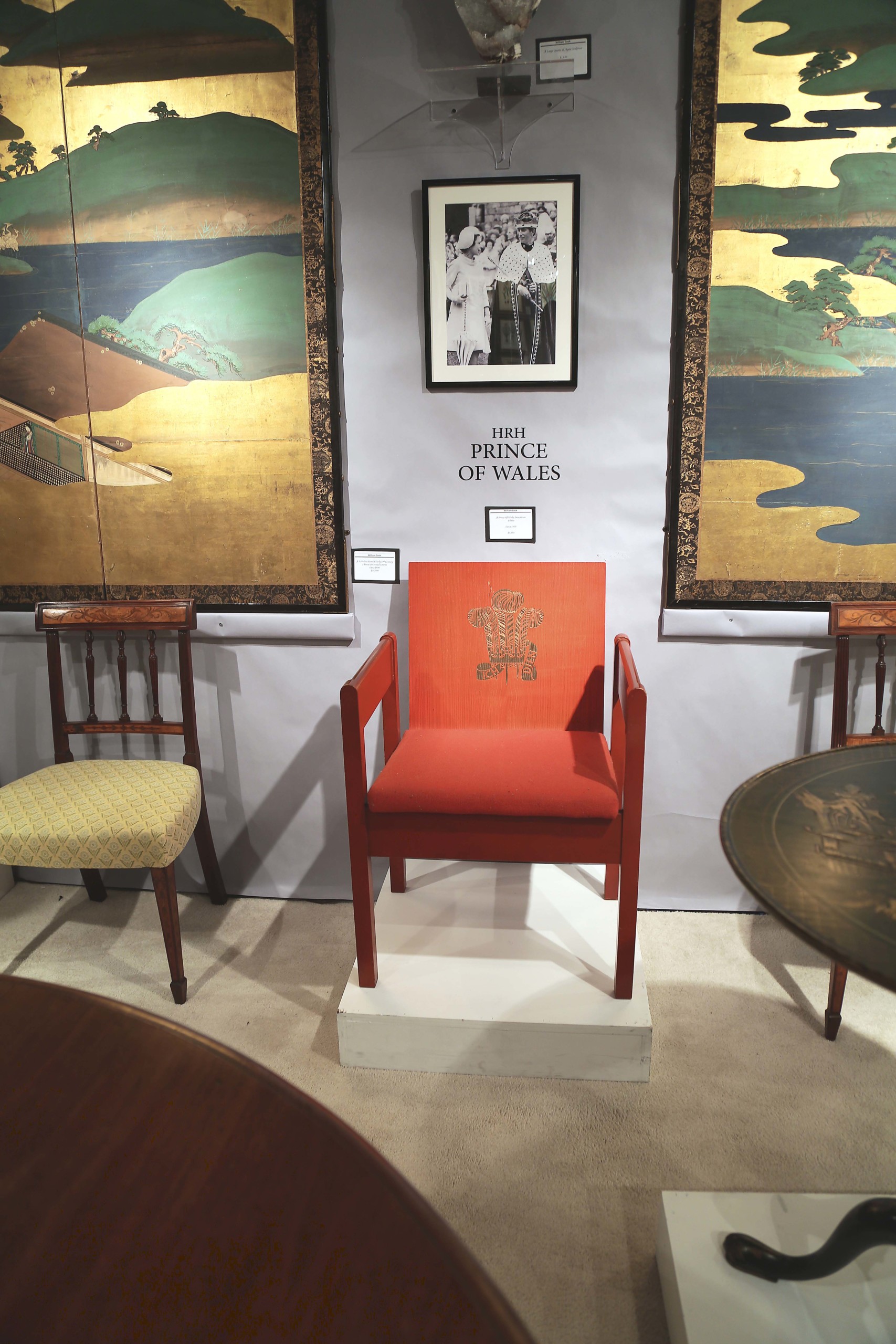
Lord Snowden, who was married to Princess Margaret, designed chairs for the guests of the 1969 investiture of Charles, Prince of Wales. Though not many survived, this is the second such one William Cook has handled; the last one he sold at the 2024 Charleston Show to a local collector. William Cook Antiques, Hungerford, UK.
Across the show floor, more Americana was in plentiful supply in the booth of Ron and Joyce Bassin, who are A Bird In Hand Antiques. Ron was pleased to show us a landscape triptych of the Maine Coast that dated to the 1920s-40s and had been found in a cabin in Maine. Among the decoys, folk portraits, small furniture and Grenfell mats the Florham Park, N.J. dealers offered was a selection of weathervanes that included a large pig weathervane featured in Robert Bishop’s American Folk Sculpture (1974).
Callaghans of Shrewsbury (UK) had a wide variety of two- and three-dimensional works by contemporary artists Bernard, Tobias Martin, Ben Waddams, Richard Smith, Alan Halliday and Marc Esteve, with historically influenced works by Antoine Bouvard, Sr; Francois Call; Gabriel Deschamps; Eugene Paul; and Montague Dawson.
When one of the intended exhibitors backed out at the last minute, Gary Sergeant’s associate, Andrew Ronan, stepped up to take an additional booth to the one he’d already committed to. He worked both sides of the aisle to speak with people looking at their offerings. The Woodbury, Conn., dealer likes to have pieces published in reference books and brings those to show, placing them alongside the objects. Among these were a rare English Croft table from 1794, a shield-back chair attributed to Samuel McIntire, a Queen Anne pier mirror, a Chippendale card table from Newport and a Federal lolling chair.
“It was a very good show and very promising, looking forward. We had a lot of really great conversations that project an exceptionally strong show for us.” Ronan noted his best sale was a Salem, Mass., lolling chair, with provenance to Israel Sack and Mitchell Taradash, sold to a young couple brought in by a young designer.
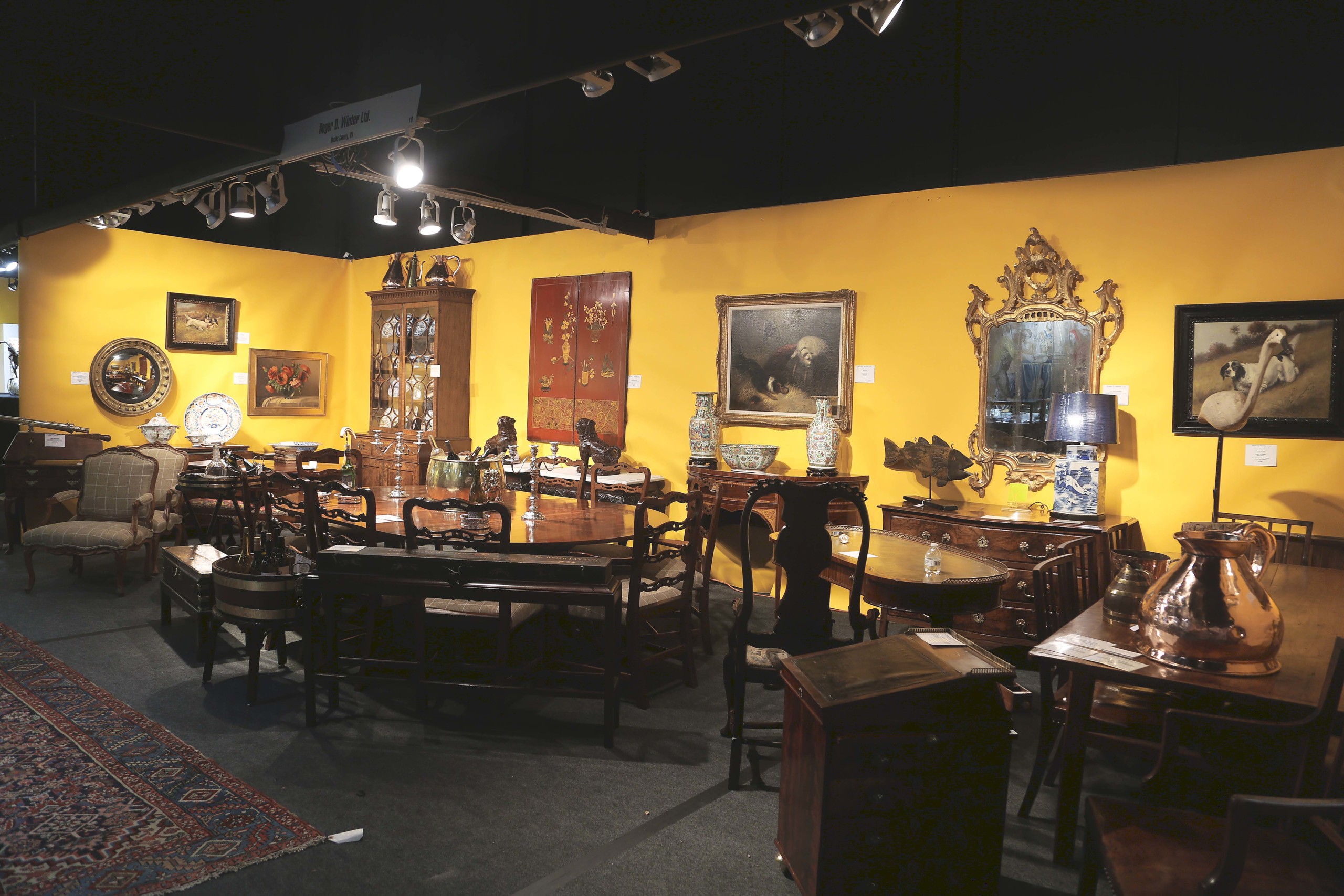
Sales on opening night included the pair of Mandarin vases on the center of Roger D. Winter’s back wall. Bucks County, Penn.
Down the aisle from Ronan, Roger Winter had a long booth full of tables, chairs and case pieces, with mirrors and paintings on the walls. Among interesting objects were two gun cases with peerage provenance: one that was painted and made for Sir John Paxton, the other of leather that was made for the Duke of Portland. On preview night, the Bucks County, Penn., dealer sold a pair of Mandarin vases on wood stands.
Ronald Greenwald, of Cleveland, was Winter’s neighbor, and he tallied a handful of sales on opening night. Among these were a pair of etched hurricane glass shades and a sterling flatware set in a case.
Until recently, husband-and-wife team Thierry and Jasmine Doussiere, of Baltimore and Marseilles, France, have combined their various areas of expertise in one booth — French fine art and silver, respectively — but in Charleston, they had separate but adjoining booths that complimented each other beautifully, with some overlap. Noteworthy and newly-acquired landscape paintings Thierry had assembled included Victor Carreton’s “The Abandoned Church in the Snow,” Marcel Cosson’s “Preparing for the Ballet,” “The Meanders of The Seine River” by Albert Mallet, “The Corneille Bridge in Rouen” and “The Croisset Near Rouen” by Narcisse Guilbert and Adolphe Louis Gaussen’s “The Cornice in Marseille.”
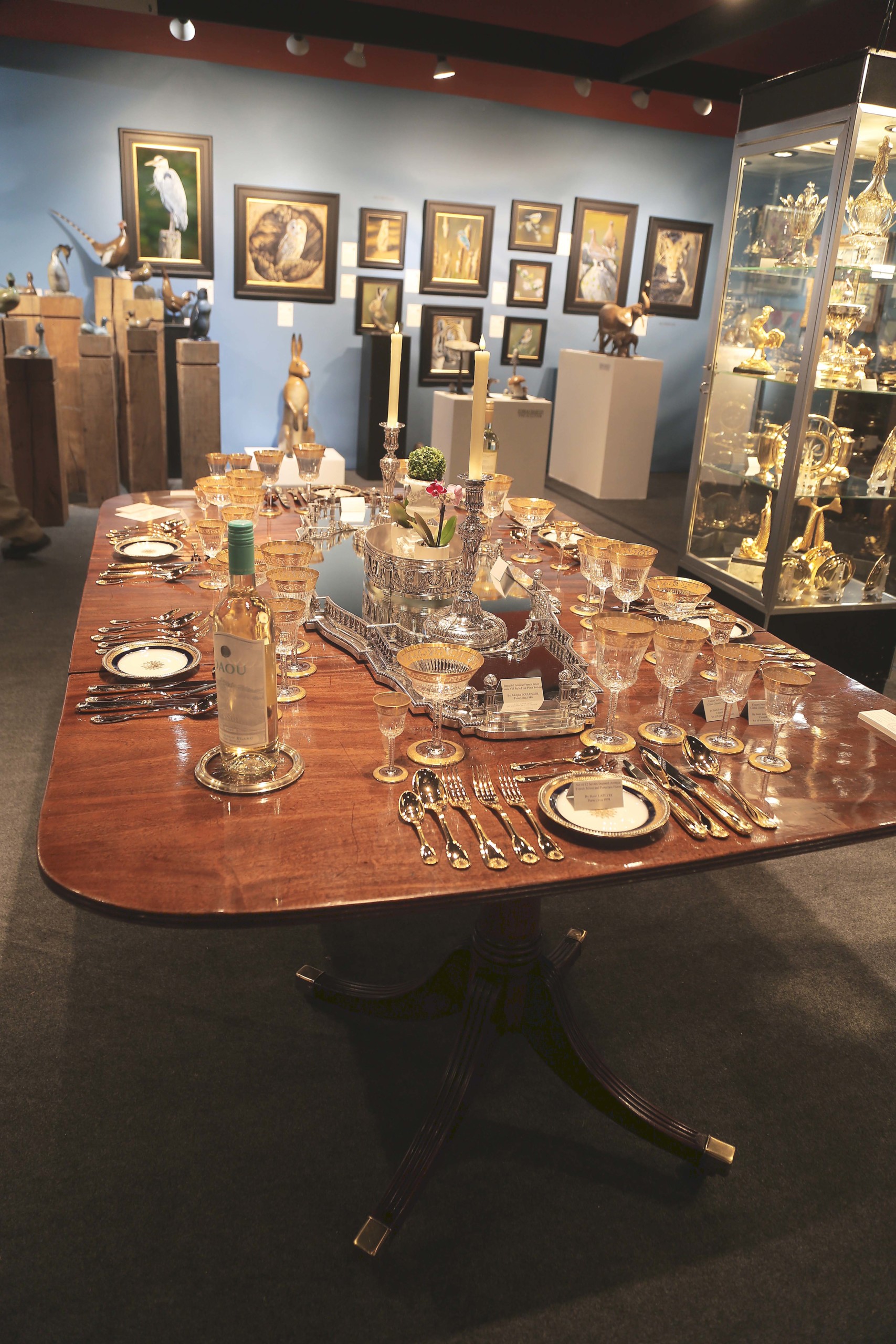
No one sets a nicer table than Jasmine Doussiere so if you’re looking for maximum impact at your next dinner party, see her. Silver Art by D&R, Baltimore & Marseilles, France.
Jasmine centered her booth around a mahogany dining table upon which were placed a Louis XVI style four-piece silver surtout, made circa 1880 by Adolphe Boulenger, a set of 12 circa 1898 Sèvres-inspired antique silver and porcelain plates by Henri LaPayre of Paris and a six-piece gilt crystal stemware service for six, made in 1908 in the Thistle pattern by Saint-Louis Cristallerie. A case at the front corner of her booth had gilt animalier bronzes by Emmanuel Fremiet and Ferdinand Pautrot.
Following the show, Jasmine reported for both of them:
“There was a wonderful interest in the French Impressionist and Post Impressionist paintings on offer. While not all resulted in sales, it was great to see people were drawn to them and eager to learn more. Several paintings left with young couples that are renovating houses locally. This demographic was one of the most interesting things this year. Many young patrons showed up at the show, which is a great indicator of a city showing a very dynamic population. It was wonderful to see this new dynamic in the show. Lots of enthusiasm and many younger visitors on top of the usual clients who did come back. Drayton Hall truly managed to drum up interest with the Young Collectors group and the lectures were quite well received and well-attended. A few antique drawings were also purchased, as well as a couple of antique French bronzes and a wonderful Eighteenth Century wood Madonna.”
She continued, “It was a pleasure to be able to introduce them to antique French silver. I sold a lovely antique French flatware set, as well as several smaller pieces. The show also drew clients from Charlotte, N.C., who acquired two extraordinary pieces: some porcelain dating back to Louis XVI’s reign and a wonderful French silver and crystal sugar bowl dating back to 1789. All in all, a great show made even more so because of the general feeling on the floor that everyone had sold. We will be back!”
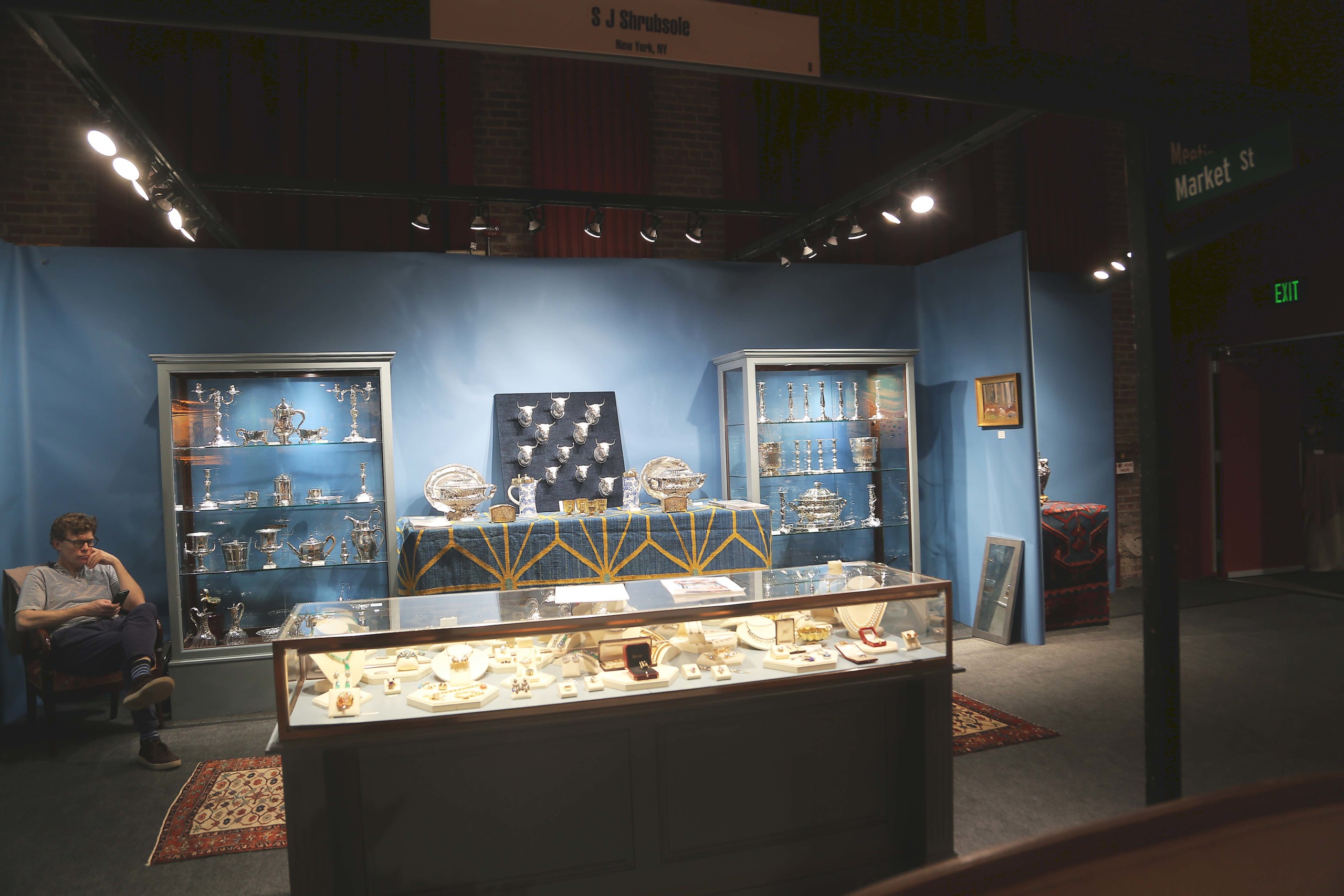
Shown on the back wall is a set of 12 stirrup cups, in the form of bull or cow’s heads, that was an unusual but important offering with S.J. Shrubsole, New York City.
Comparable English and American silver and fine art offerings could be had across the aisle at S.J. Shrubsole. The New York City dealers anchored the back of their booth with a unique set of 12 bull- and cow-form stirrup cups made in London between 1869 and 1893 by Hunt & Roskell. The set was commissioned by John Hungerford Arkwright, of Hampton Court in Herefordshire, to commemorate his championship herd of Hereford cattle; most pieces were engraved with the names of the bull or cow and the prizes the animal won at agricultural shows. A large marine painting by Henry Scott and two smaller shore landscapes by Edward W. Cooke dominated the side wall and hung adjacent to a George II silver epergne made by Eliza Godfrey in London in 1755.
Three print specialists were on hand: D.M. DeLaurentis Fine Art (Doylestown, Penn.), Arader Galleries (Philadelphia) and Dinan & Chighine (Surrey, UK). Denise DeLaurentis pointed out some important recently-acquired pieces: a series of Mark Catesby botanical engravings with local interest; an anonymous architectural study drawing for a Neoclassical monument; a series of citrus engravings by Jesuit man-of-letters, Giovanni Battista Ferrari (1584-1655); a pair of mezzotint floral engravings after Jan van Huysum; engravings of shells by George Wolfgang Knorr; and stipple engravings of “The Costume of China,” after Pu-Qua.
Arader Galleries’ Lori Cohen also brought works by Catesby, but hers were of birds (“The Parrot of Paradise of Cuba,” “The Wood Pelican” and “The Brown Curlew”) and crustaceans (“The Hermit Crab” and “The Sea Hermit-Crab”). For those whose interests run more to local history, maps of the Carolinas and Charleston were in good supply, including Henry Mouzon’s 1775 An Accurate Map of North and South Carolina…; A Northwest by North View of Charles Town…; A Northeast View of Fort Sullivans Island…; and A Plan of Attack of Fort Sullivan Near Charles Town in South Carolina… by William Faden. The Philadelphia dealer also had regional maps by Joseph Frederick Wallet des Barres, David Ramsay and William Gerard Debrahm.
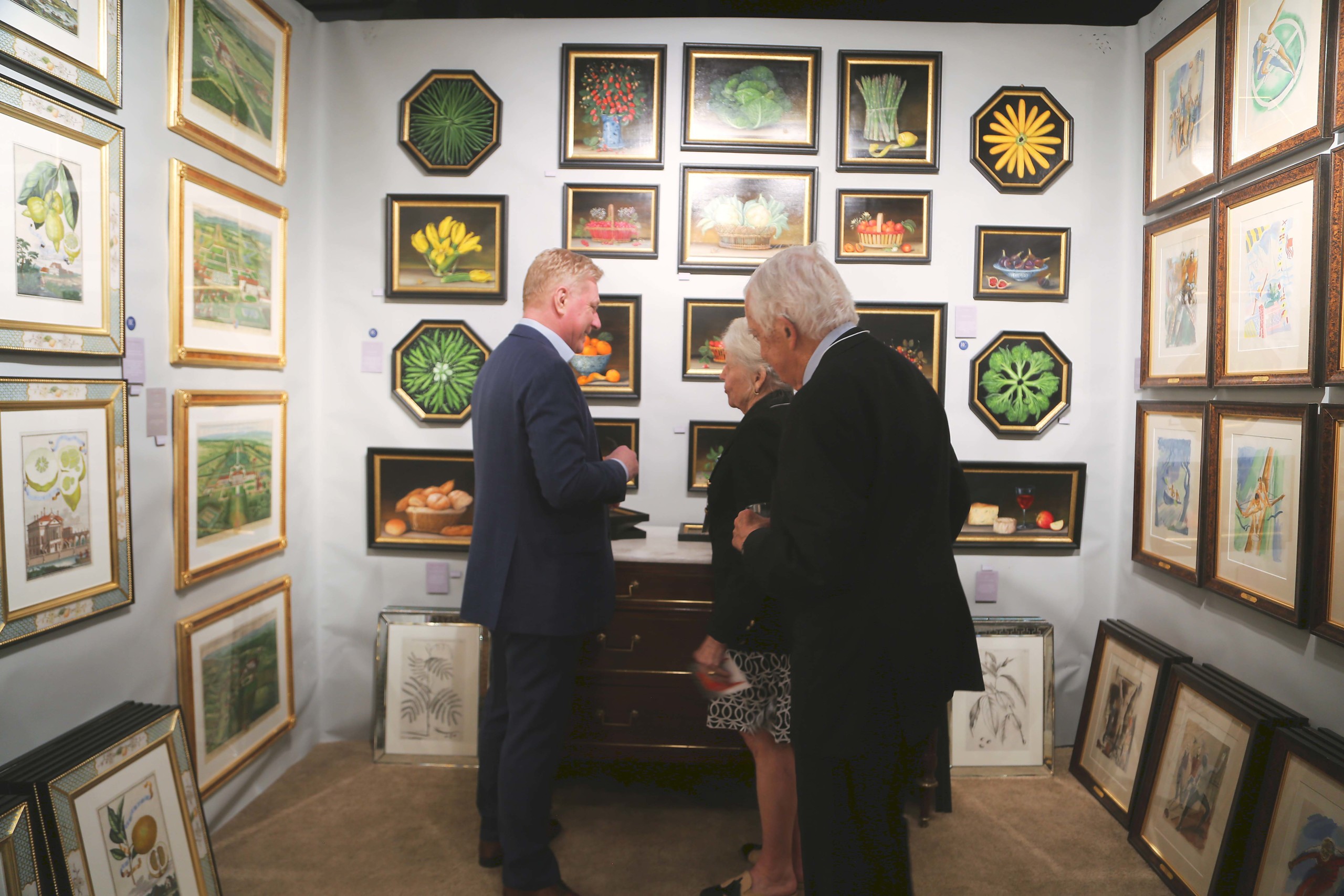
John Dinan, left, with preview party committee members Anne and Dick Keigher, in front of a wall of small still life pictures by Margaret Roberts. Dinan & Chighine, Surrey, UK.
John Dinan and Graziella Chighine brought works by several artists that could be purchased by the set or individually. In addition to contemporary still life pictures by Margaret Roberts, there were botanicals by Johannes Weinmann, copper-plate fish engravings by Marcus Eliesar Bloch and framed watercolors by Alan Halliday.
Both David Brooker (Woodbury, Conn.) and Archie Parker (London & Hampshire, UK) carried mostly sporting art. Works by John Emms and F. Cato were with Brooker, who also displayed a remarkable set of four circa 1830-40 marine paintings by Nicholas Mathew Condy and two modern still life paintings by George Weissbort.
Parker offered works by John F. Herring, both the senior and junior, as well as Francis Sartorius, Raoul Millais, Richard Barrett Davies, John Theodore Eardley Kenney, William Jones and Philip Reinagle.
There were a lot of luxurious booths at the show but the most sumptuous would have to have been that of B. Viz Design, New Orleans. Rebecca Vizard sources antique and contemporary Suzani textiles from Uzbekistan and works them into elegant statement throw pillows, tapestry panels or long elegant and unique coats. Her bed hangings are popular among decorators for hanging over the backs of sofas or at the end of a bed.
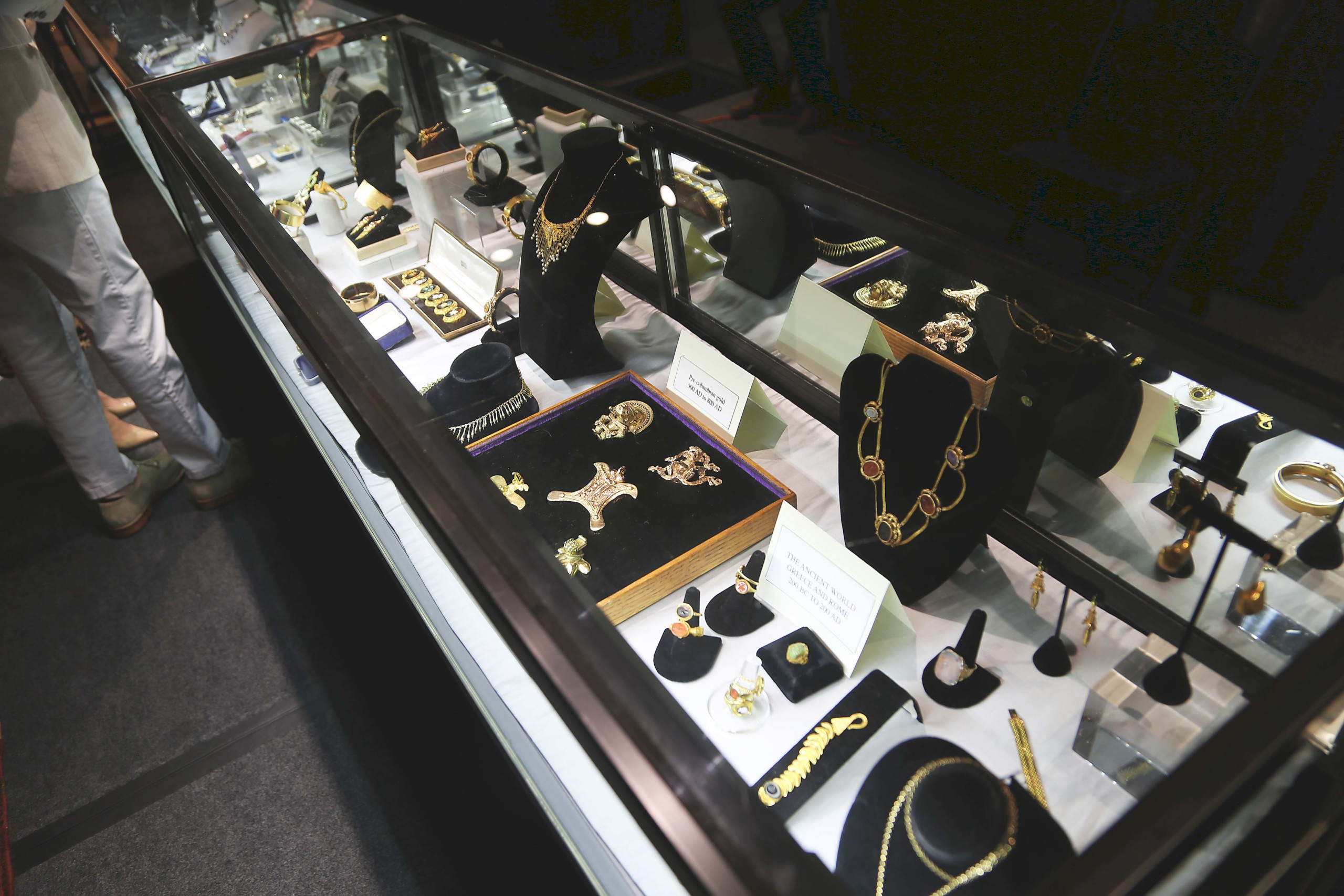
Classical (200 BCE-200 CE) and pre-Columbian jewelry (500-800 CE). Birdsall-Haase, St Paul, Minn.
Several dealers had antique jewelry; Michael Birdsall and Roger Haase (St Paul, Minn.)specialize exclusively in it and brought a range that included pieces from Ancient Greece and Rome (200 BCE-200 CE), pre-Columbian (500-800 CE), Eighteenth and early Nineteenth Century jewelry from England and France, Italian Grand Tour jewelry (1800-1870) and European jewelry from the second half of the Nineteenth Century.
Victorian love jewelry was front and center in Baltimore-based Moylan-Smelkinson/The Spare Room’s booth, with several name pins stuck to a vertical display. Jackie Smelkinson said they were usually given as gifts and said the best resource was Ann Louise Luthi’s Sentimental Jewellery: Antique jewels of love and sorrow (2001).
Kaye Gregg and Marty Shapiro, who own Chicago’s Finnegan Gallery, had the lock on garden furniture, architectural elements, lighting and eclectic accessories from both Europe and the US. Several pieces were marked with red “sold” dots on opening night: an English cotton diorama that featured differently tied skeins and samples of cotton, two large faux bois planters and a faux bois garden seat.
The 2026 Charleston Show is scheduled for March 20-22, with an Opening Night party on Thursday, March 19. For information, www.thecharlestonshow.com.
